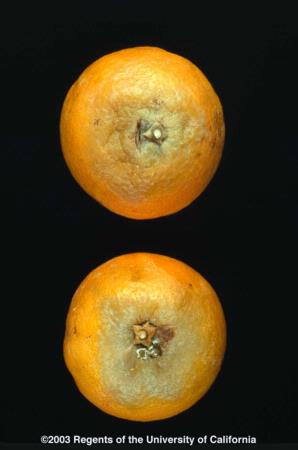Brown Rot on Citrus
By Andrea Peck UCCE Master Gardener
What are the brown spots on my oranges? Margot S, Arroyo Grande
Brown spots or lesions on citrus usually mean one thing: brown rot. Brown rot is a disease that affects all parts of the tree, but is most often observed on the fruit. It is transmitted via various forms of the pathogen, Phytophthora, which resides in the soil. During wet weather, Phytophthora is bounced up from the ground by rain and wind. Continued moisture creates a hospitable environment for growth. Because of the nature of transmission, the lower canopy of the tree is particularly susceptible. In the beginning stages, the infection is not visible to the eye, but as time goes on the site will develop a whitish growth which will inevitably become a round, leathery stain.
Brown rot is not just aesthetic--infected fruit has a pungent odor and is generally inedible. It can damage branches, decrease vigor and affect the overall health and bounty of the tree. For the commercial grower, brown rot is a significant issue. Fruit may not show signs of damage at harvest and infected fruit may spread the disease during shipment. In 2013 this problem was so severe that shipping of citrus to China was shut down due to infected fruit. That ban has since been lifted, but a continued system of monitoring remains.
All citrus growing regions of California have Phytophthora and no citrus is immune. Prevention is usually your best bet. Pruning the lower branches so that there is at least 24 inches between the branches and the soil decreases the possibility of infection. Keep sprinklers and hoses away from the tree and apply irrigation directly to the soil instead. Prune the canopy of the tree to allow adequate light and air circulation. Use copper spray in late August and again in October to create a layer of protection. When rains are heavy, an additional application in January may be required. Spray all parts of the tree, including the underside of the leaves, the trunk and the soil below. With a little luck, you'll have a 'fruitful' year!
